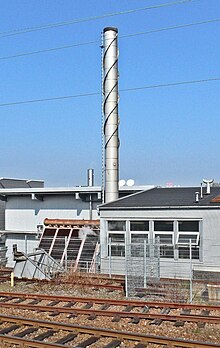Vortex shedding
This article focuses only on one specialized aspect of the subject. (October 2019) |


In fluid dynamics, vortex shedding is an oscillating flow that takes place when a fluid such as air or water flows past a bluff (as opposed to streamlined) body at certain velocities, depending on the size and shape of the body. In this flow, vortices are created at the back of the body and detach periodically from either side of the body forming a Kármán vortex street. The fluid flow past the object creates alternating low-pressure vortices on the downstream side of the object. The object will tend to move toward the low-pressure zone.
If the bluff structure is not mounted rigidly and the frequency of vortex shedding matches the resonance frequency of the structure, then the structure can begin to resonate, vibrating with harmonic oscillations driven by the energy of the flow. This vibration is the cause for overhead power line wires humming in the wind,[1] and for the fluttering of automobile whip radio antennas at some speeds. Tall chimneys constructed of thin-walled steel tubes can be sufficiently flexible that, in air flow with a speed in the critical range, vortex shedding can drive the chimney into violent oscillations that can damage or destroy the chimney.
Vortex shedding was one of the causes proposed for the failure of the original Tacoma Narrows Bridge (Galloping Gertie) in 1940, but was rejected because the frequency of the vortex shedding did not match that of the bridge. The bridge actually failed by aeroelastic flutter.[2]
A thrill ride, "VertiGo" at Cedar Point in Sandusky, Ohio suffered vortex shedding during the winter of 2001, causing one of the three towers to collapse. The ride was closed for the winter at the time.[3] In northeastern Iran, the Hashemi-Nejad natural gas refinery's flare stacks suffered vortex shedding seven times from 1975 to 2003. Some simulation and analyses were done, which revealed that the main cause was the interaction of the pilot flame and flare stack. The problem was solved by removing the pilot.[4]
Governing equation
[edit]The frequency at which vortex shedding takes place for a cylinder is related to the Strouhal number by the following equation:
Where is the dimensionless Strouhal number, is the vortex shedding frequency (Hz), is the diameter of the cylinder (m), and is the flow velocity (m/s).
The Strouhal number depends on the Reynolds number ,[5] but a value of 0.22 is commonly used.[6] As the unit is dimensionless, any set of units can be used for the variables. Over four orders of magnitude in Reynolds number, from 102 to 105, the Strouhal number varies only between 0.18 and 0.22.[5]
Mitigation of vortex shedding effects
[edit]
Fairings can be fitted to a structure to streamline the flow past the structure, such as on an aircraft wing.
Tall metal smokestacks or other tubular structures such as antenna masts or tethered cables can be fitted with an external corkscrew fin (a strake) to deliberately introduce turbulence, so the load is less variable and resonant load frequencies have negligible amplitudes.[7] The effectiveness of helical strakes for reducing vortex induced vibration was discovered in 1957 by Christopher Scruton and D. E. J. Walshe at the National Physics Laboratory in Great Britain.[8] They are therefore often described as Scruton strakes. For maximum effectiveness in suppression of vortices caused by air flow, each fin or strake should have a height of about 10 percent of the cylinder diameter. The pitch of each fin should be approximately 5 times the cylinder diameter.[9]

A tuned mass damper can be used to mitigate vortex shedding in stacks and chimneys.
A Stockbridge damper is used to mitigate aeolian vibrations caused by vortex shedding on overhead power lines.
See also
[edit]- Aeroelastic flutter - vibration-induced vortices - by way of contrast
- Vortex
- Vortex-induced vibration
- Von Kármán vortex street
References
[edit]- ^ The Mechanical Universe: Mechanics and Heat, Advanced Edition, p. 326
- ^ K. Billah and R. Scanlan (1991), Resonance, Tacoma Narrows Bridge Failure, and Undergraduate Physics Textbooks, American Journal of Physics, 59(2), 118--124 (PDF)
- ^ Maureen Byko (May 2002). "Materials Give Roller Coaster Enthusiasts a Reason to Scream". The Minerals, Metals & Materials Society. Archived from the original on 8 February 2007. Retrieved 2009-02-22.
- ^ "Engineering Service". Archived from the original on December 31, 2015. Retrieved 2016-06-22.
{{cite web}}: CS1 maint: unfit URL (link) - ^ a b "Strouhal number". Archived from the original on 2010-05-01. Retrieved 2020-02-14.
- ^ J. P. Den Hartog (2013). Mechanical Vibrations. Dover Publications. p. 305. ISBN 978-0486131856.
- ^ R. J. Brown. "VIV Lecture" (PDF).
- ^ Scruton, C.; Walshe, D.E.J. (October 1957) "A means for avoiding wind-excited oscillations of structures with circular or nearly circular cross section" National Physics Laboratory (Great Britain), Aerodynamics Report 335. (unpublished)
- ^ "Helical Strakes". VIV Solutions LLC. Retrieved 19 January 2017.






